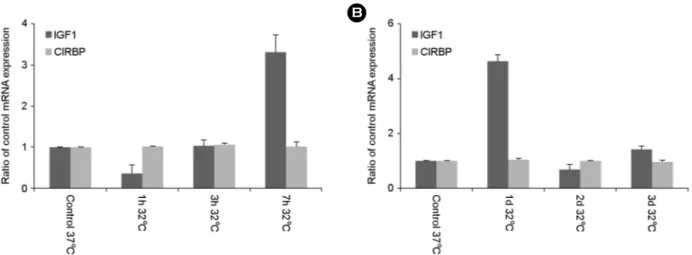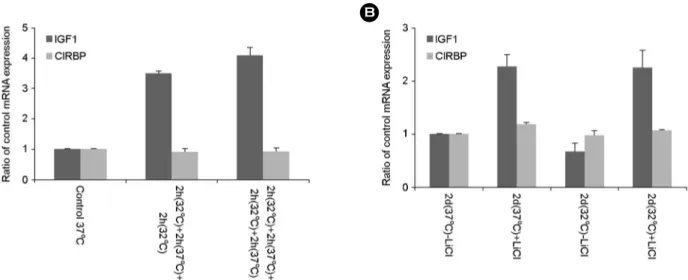Biomedical Science Letters 2017, 23(1): 39~43 http://dx.doi.org/10.15616/BSL.2017.23.1.39 eISSN : 2288-7415
Hypothermia Regulates Insulin-like Growth Factor 1 Gene Expression in PC12 Cells
Bo-Kyung Yoo
1,§, Kisang Kwon
2,§, Eun Ryeong Lee
2, Seung-Whan Kim
3, Kweon Yu
4and O-Yu Kwon
1,†1
Department of Anatomy & Cell Biology, College of Medicine, Chungnam National University, Daejeon 35015, Korea
2
Department of Biomedical Laboratory Science, College of Health & Welfare, Kyungwoon University, Gumi 39160, Korea
3
Department of Emergency Medicine, Chungnam National University Hospital, Daejeon 35015, Korea
4
Korea Research Institute of Bioscience & Biotechnology, Daejeon 34141, Korea
In this study, we evaluated the effects of various hypothermic conditions (32℃), including lithium chloride treatment, on insulin-like growth factor 1 (IGF-1) gene expression in PC12 cells. The results show that short-term hypothermic treatment (<1 day) resulted in relatively higher IGF-1 gene expression than did longer-term treatment (>1 day). Repeated switching between normal temperature and hypothermia every 2 h increased IGF-1 gene expression approximately 3-4-fold. These findings indicate that hypothermia dynamically regulates IGF-1 gene expression. This study could be helpful for the development of treatment and diagnostic strategies for ischemia.
Key Words: Hypothermia, Insulin-like growth factor 1 (IGF-1), PC12 cells
Currently, clinical treatments that reduce the after-effects of acute ischemic stroke are not well established. Tissue plasminogen activator (t-PA) injection therapy within 3 h post-acute ischemic stroke is one of the most effective methods. However, t-PA is associated with serious issues, such as time limitations and risk of bleeding (Wardlaw et al., 2012). Anti-platelet agents have recently received much attention for their therapeutic effects. However, these effects remain unclear. Hypothermia treatment is defined as a core body temperature below 35℃ (32℃) to achieve protection and/or good clinical outcomes. Its advantages were shown for the medical management of refractory intracranial hyper-
tension and malignant cerebral edema (Imataka and Arisaka, 2015). American Heart Association guidelines on therapeutic hypothermia (2005) state that unconscious adult patients with return of spontaneous circulation after out-of-hospital cardiac arrest should be cooled to 32~34℃ for 12~24 h, and similar therapy may be beneficial for patients with non-ventricular fibrillation (VF) arrest out of hospital or in hospital (American Heart Association, 2006). Although hypothermia treatment has many benefits for neurocritical care and patient rehabilitation, the mechanisms involved in the regulation of cellular function are obscure. The molecular mechanisms proposed include apoptosis and mitochondrial
Brief Communication
*Received: October 14, 2016 / Revised: February 8, 2017 / Accepted: February 9, 2017
§Authors contributed equally to this work.
†Corresponding author: O-Yu Kwon. Department of Anatomy & Cell Biology, College of Medicine, Chungnam National University, Daejeon 35015, Korea.
Tel: +82- 42-580-8206, Fax: +82-42-586-4800, e-mail: oykwon@cnu.ac.kr
○CThe Korean Society for Biomedical Laboratory Sciences. All rights reserved.
○CCThis is an Open Access article distributed under the terms of the Creative Commons Attribution Non-Commercial License (http://creativecommons.org/licenses/by-nc/3.0/) which permits unrestricted non-commercial use, distribution, and reproduction in any medium, provided the original work is properly cited.

